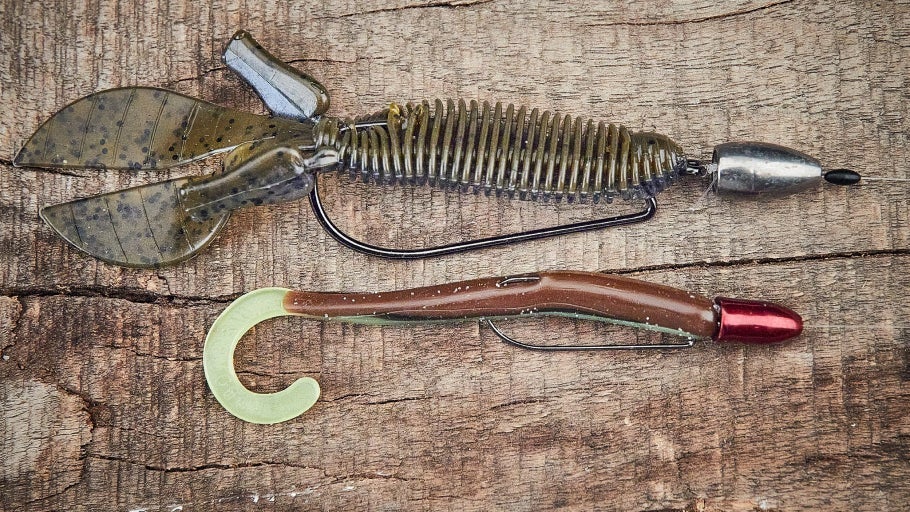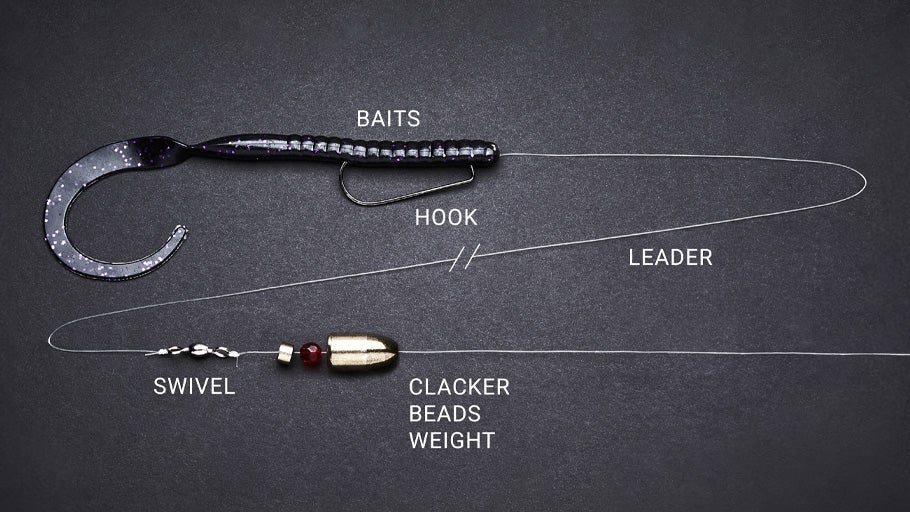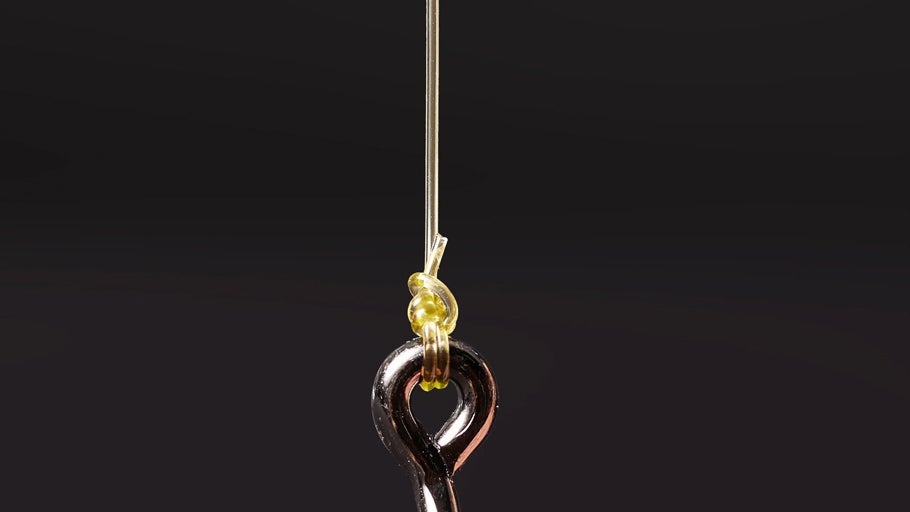
Free Rigs Gear Guide
Popularized in Japan and gaining traction around the world, the free rig shares some of the same fish-catching attributes of a Texas rig, but with a sinker that slides up and down the line more freely than an unpegged bullet weight. The enlarged opening on a free rig weight allows it to fall quickly, so soft plastics hover in the strike zone with a natural free-flowing appearance and unique falling action as they glide slowly through the water column.
A recipe for success in the hands of any new angler looking to get bit, the free rig is a fun and productive bass-fishing tactic that provides the rigging versatility to customize your hooks, weights, and soft plastics based on the situation. In this article, we’ll explore the optimal finesse and power fishing tackle setups for free rigs, dive into the wide scope of rigging options, and give some insight into color selection.
Free Rig Rods
Free rigs provide opportunities to catch fish with heavy-duty casting gear or with finesse tackle on your favorite spinning setup, so the ideal rod is going to depend on angler preference, your approach, and what kind of cover you’re dealing with. For most situations, the same rod you would use for a casting jig or Texas rig is going to perform well as an all-purpose rod for free rig applications. A medium-heavy 7’ to 7’6” casting rod with a fast to extra-fast taper allows the rod to bend quickly near the tip and load into the backbone for positive hooksets. If you’re targeting highly pressured or finicky fish, try throwing the free rig on your favorite spinning rod and downsizing your hooks, weights, and lures.
Free Rig Reels
As we mentioned before, your favorite jig setup is a great place to start when fishing the free rig, and a compact 100 to 150-size baitcasting reel is often preferred so you can keep your fingers in direct contact with the blank to detect bites. Just like Texas rigs, the free rig doesn’t require specialized fishing equipment, but you may want the added speed of a 7:1 gear ratio or faster to pick up line quickly to deliver a solid hookset. If you’re fishing the free rig on spinning tackle, the gear ratio and reel size are less important, as any 2000 to 3000 spinning reel that holds plenty of your desired fishing line will get the job done.
Free Rig Line
Although bass anglers can adapt their free rigs to a variety of fishing situations ranging from finesse to heavy-duty, most anglers prefer to use a 12 to 16-lb fluorocarbon and a casting outfit for all-purpose applications. On spinning gear, a 10 to 20-lb braided main line to a long 8-lb fluoro leader is a great combination to target finicky smallmouth in open water. Conversely, when fishing the free rig around thick cover, heavy casting gear with a 30 to 50-lb braided main line and 12 to 20-lb fluorocarbon leader is often required for turning a big largemouth away from cover.
Modifications & Rigging
Extremely simple and easy to rig, a free rig comes together just like a Texas rig except instead of using a bullet weight, a cylinder or bell-shaped weight built with a skinny circular eyelet allows the weight to slide up and down your mainline. A 1/4 oz is typically best for most situations, but you’re often using one size smaller than you would on a Texas rig, aiming for a 3/16 oz in shallow areas and up to a 3/8 oz for deep water brush. There are endless weight sizes and hook options that could be used with the free rig to make this rig unique to your personal preferences.
For super heavy cover applications, you might be pairing a straight shank flipping hook with a creature bait, open water situations often call for an extra-wide gap hook and your favorite soft plastic, or you may even be using a small offset hook and worm to go finesse. Lures with lots of appendages, specific-gravity salt content, or TPE plastic like Elaztech offer additional float to heighten the lure‘s ability to suspend and deliver natural free-flowing action. Lastly, it‘s always a good idea to keep a brightly colored marker or dipping dye on hand to provide a splash of color on your soft plastics and increase attraction.
Colors
Green pumpkin and watermelon variations are a great place to start when selecting colors, but always consider the type of forage you’re trying to imitate and the water clarity. Keep in mind that the free rig is more of a visual presentation compared to a Texas rig or football jig, so natural colors are often more desirable if you’re fishing clear water or targeting pressured or suspended fish. During the springtime, the free rig is a great bed-fishing lure as it hovers in the face of fish longer than a Texas rig, so bright colors like white, chartreuse, or merthiolate add an element of aggravation to provoke fish into biting.
As fishing pressure continues to increase and technology advances, slight shifts in your presentation can make all the difference, and the free rig lets you fish soft plastics in a unique way that stands out from the rest of the crowd. Just keep in mind that a free rig provides anglers with a more suspended fishing approach that falls vertically and adds a more subtle presentation to your arsenal to keep the bites coming during tough fishing conditions.
Related Articles






















































































